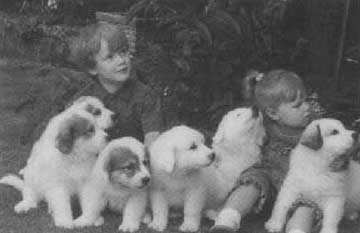(Extracts from the Hanbook of PMDC of GB - Copies available from the Secretary)
Grooming
An essential precursor to grooming your Pyrenean is that right from the start you must get him used to being handled. The first exercise is to stand him on a table with a non-slip mat or on the floor depending on size, then gently look in his mouth and brush the coat over with a firm, not a wire, brush. Even if the dew-claws don't need cutting handle them, examine the pads on each foot and comb the trousers and tail. Next, lie the puppy on its side, holding him down firmly, if he objects raise your voice or give a quick shake if necessary. When he accepts you doing this then praise him lavishly and let other family members do the same, although this can called for a lot of patience on your part. However it is well worthwhile in the long run as a lot of Pyreneans develop an intense dislike of having their dew-claws cut and their tail and trousers groomed.
 Puppy hood is the most
difficult time for looking after a Pyrenean's coat, if
care is not taken then that nice fluffy coat that makes
a puppy so attractive can soon become a solid mat that
can only be removed with scissors. To avoid this, daily
grooming is recommended until the puppy coat is shed and
replaced by an adult one. A comb with rounded ends to
the teeth is the best tool for keeping the puppy coat
under control. Pay extra attention to the "trousers" and
the area under the ears as this is where most problems
occur. If you find and "hot spots" (a small area of
reddened skin) then apply some TCP or medicated talc as
this will often clear them up. While you should try to
make grooming a happy time for the puppy avoid it
becoming a game by reprimanding him sternly if he tries
to hold either the brush or your fingers.
Puppy hood is the most
difficult time for looking after a Pyrenean's coat, if
care is not taken then that nice fluffy coat that makes
a puppy so attractive can soon become a solid mat that
can only be removed with scissors. To avoid this, daily
grooming is recommended until the puppy coat is shed and
replaced by an adult one. A comb with rounded ends to
the teeth is the best tool for keeping the puppy coat
under control. Pay extra attention to the "trousers" and
the area under the ears as this is where most problems
occur. If you find and "hot spots" (a small area of
reddened skin) then apply some TCP or medicated talc as
this will often clear them up. While you should try to
make grooming a happy time for the puppy avoid it
becoming a game by reprimanding him sternly if he tries
to hold either the brush or your fingers.
In the adult a good brush twice a week should be enough to keep the coat in good order, backed up by combing when the coat is being shed. Excessive bathing is not good for the coat, so where possible try to keep him clean with regular brushing backed up by rubbing badly soiled parts with a chamois leather or something similar.
Trim the long hair around the feet, between the toes and the pads under the feet. Another place to carefully use the scissors is on the long hairs that grow above the eye which, if neglected, can grow right round and into the eye causing irritation.
Nails
The nails on a dog will normally be kept quite short if the dog is exercised sufficiently on a hard surface; tailing this it will be necessary to either cut (using a guillotine type nail-cutter) or file down the nails, the latter being preferred if the dog has black nails as a few Pyreneans do and extreme care should be taken not to cut into the "quick" (with white nails this can be seen as a pink interior). Pyreneans of course have rear double dew-claws as a breed characteristic and as on some dogs these grow quickly, regular inspection should be made to prevent the dew-claw from growing round in a complete circle and the tip becoming embedded in the leg. On no account must these be removed - some vets might recommend this if they are unaware of the Breed Standard.